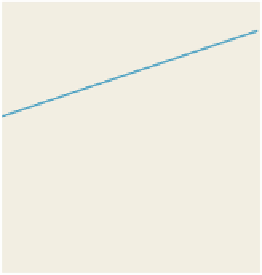Graphics Reference
In-Depth Information
function like the square wave we saw above, the measurement process averages
values to the left and right of
t
0
, and the limit (in the case of a square wave) is
the average of the upper and lower values. In cases messier than these simple
ones, it can happen that the limit in Equation 18.27 can fail to exist, in which case
the sample of
f
is not defined. We'll never encounter such functions in practice,
though.
The somewhat complex definition of sampling suggests that the mathematical
details of
L
2
functions can be quite messy. That's true, and making precise state-
ments about sampling, convolution, Fourier transforms, etc., is rather difficult.
Often the statement of the preconditions is so elaborate that it's quite difficult to
understand what a theorem is really saying. Rather than ignoring the preconditions
or precision, which leads to statements that seem like nonsense except to the very
experienced, and rather than providing the exact statements of every result, we'll
restrict our attention, to the degree possible, to “nice” functions (see Figure 18.25)
that are either continuous, or very nearly continuous, in the sense that they have a
discrete set of discontinuities, and on either side of a discontinuity they are contin-
uous and bounded (i.e., there's no “asymptotic behavior” like that of the graph of
y
=
1
Figure 18.25: A few “nice” func-
tions.
x
near
x
=
0). Figure 18.26 shows some functions that are not nice enough
to study in this informal fashion, but which also don't arise in practice.
/
The restriction to “nice” functions is enough to make most of the subtleties
disappear. It's also appropriate in the sense that we're using these mathematical
tools to discuss physical things, like the light arriving at a sensor. At some level,
that light intensity is discontinuous—either another photon arrives or it doesn't—
but at the level at which we're hoping to model the world, it's reasonable to treat
it as a continuous function of time and position.
We're also typically studying the result of
convolving
the “arriving light” func-
tion with some other function like a box; the box is a nice enough function that
convolving with it always yields a continuous function, and sampling this
contin-
uous
function is easy—we just evaluate at the sample points. So the way we work
with light tends to mean that we're working with functions that “behave nicely”
when we look closely at the mathematics.
Figure 18.26: “Not-nice” func-
tions. The blue function is
0
except at points of the form p
2
q
,
/
where its value is
1
/
2
q
.
2
For the remainder of this chapter, we'll be considering things in one dimen-
sion: Our “images” will consist of just a row of pixels; our sensor will be a line
segment rather than a rectangle, etc. We'll sometimes
illustrate
the corresponding
ideas in two dimensions (i.e., on ordinary images), but we'll write the mathemat-
ics in one dimension only. So we'll be working with a function
f
defined on the
real line, and its samples defined on the integers. To make things simpler, we'll
restrict our attention to the case where
f
is an
even function
(see Figure 18.27),
where
f
(
x
)=
f
(
1
0
−
1
−
2
x
)
for every
x
. Examples of even functions are the cosine, and
the squaring function. Restricting to even functions lets us mostly avoid using
complex numbers, while losing none of the essential ideas.
To review what we've done so far, we've defined convolution, and observed
that many operations like display of images, capturing images by sensing (i.e.,
photography or rendering), blurring or sharpening of images, etc., can be writ-
ten in terms of convolution, and that sampling at a point is defined by a limit of
integrals, while sampling at all points is a limit of convolutions.
−
−
3
−
5
0
5
Figure 18.27: An even function is
one symmetric about the y-axis.






















































